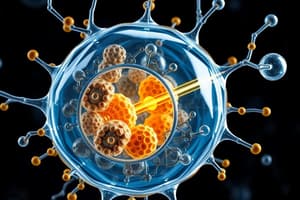Podcast
Questions and Answers
What defines a substance as an element?
What defines a substance as an element?
- It cannot be broken down by ordinary chemical means. (correct)
- It contains atoms of two or more different elements.
- It can be broken down into simpler substances.
- It is always made up of molecules.
Which statement best describes an ion?
Which statement best describes an ion?
- An ion consists of two or more different elements.
- An ion contains only protons and neutrons.
- An ion is a neutral atom without any charge.
- An ion is positively or negatively charged due to electron loss or gain. (correct)
What is the primary function of ribosomes in a cell?
What is the primary function of ribosomes in a cell?
- They synthesize lipids.
- They are the site of protein synthesis. (correct)
- They produce energy through ATP.
- They break down foreign or damaged materials.
Which of the following organelles is responsible for producing energy in the form of ATP?
Which of the following organelles is responsible for producing energy in the form of ATP?
Cell differentiation during embryonic development involves which process?
Cell differentiation during embryonic development involves which process?
What role does the Golgi apparatus play in the cell?
What role does the Golgi apparatus play in the cell?
What happens to cell growth after an injury?
What happens to cell growth after an injury?
Which of the following elements is NOT commonly present in organic compounds?
Which of the following elements is NOT commonly present in organic compounds?
Flashcards
Element
Element
A substance that cannot be broken down into a simpler substance by ordinary chemical means.
Atom
Atom
The smallest particle of an element that retains its properties and characteristics.
Ion
Ion
An atom that is positively or negatively charged through gaining or losing electrons.
Compound
Compound
Signup and view all the flashcards
Cell Membrane
Cell Membrane
Signup and view all the flashcards
Mitochondria
Mitochondria
Signup and view all the flashcards
Cell Differentiation
Cell Differentiation
Signup and view all the flashcards
Cell Replacement
Cell Replacement
Signup and view all the flashcards
Study Notes
Atomic Structure
- Element: A substance that cannot be broken down into simpler substances chemically.
- Atom: The smallest particle of an element retaining its properties.
- Ion: An atom with a positive or negative charge due to electron gain/loss.
- Compound: A substance with two or more elements' atoms.
- Organic Compounds (Carbon Backbone): Compounds containing carbon, often covalently bonded. Examples include proteins, DNA, carbohydrates, lipids. Common elements are hydrogen, oxygen, sulfur, phosphorus, and nitrogen.
Cells
- Cell Membrane: Outer boundary, selectively permeable, phospholipid bilayer.
- Nucleus: Controls cell growth, metabolism, and reproduction; contains chromosomes directing protein synthesis.
- Cytoplasm: Cell substance excluding the nucleus; contains organelles for specific cell functions.
- Mitochondria: Thread-like structures producing ATP (energy).
- Ribosomes: Sites of protein synthesis.
- Endoplasmic Reticulum (ER):
- Rough ER: Ribosome-covered, produces proteins.
- Smooth ER: Produces enzymes for lipid synthesis.
- Golgi Apparatus: Produces carbohydrate molecules for secretion, such as lipoproteins (fat transport).
- Lysosomes: Digestive bodies breaking down foreign/damaged material.
Cell Function
- Energy Production: Cells create energy (ATP).
- Protein Synthesis: Cells make proteins, DNA, and other materials.
- Growth/Division: Cells grow and replicate through mitosis.
- Secretion: Produce and release specialized substances.
- Differentiation: Cells specialize for specific tasks.
- Interaction: Cells interact to form tissues and organs.
- Movement: Cells can move.
- Death: Cells have a lifespan.
Cell Replacement and Damage
- Cell Turnover: Millions of skin, mouth, and GI tract cells are replaced daily due to mitosis in somatic cells.
- Cell Repair: Cell growth accelerates after injury to quickly repair tissue.
- Long-Term Damage/Infection: Prolonged damage increases infection risk.
- Embryonic Development: Early development involves cell specialization..
Cell Differentiation
- Adaptation: Cells adapt and lose some functions to become efficient for specialized roles.
Studying That Suits You
Use AI to generate personalized quizzes and flashcards to suit your learning preferences.
Description
Explore the fundamental concepts of atomic structure and cell biology in this quiz. Understand the definitions of elements, atoms, ions, and various cell components, including the cell membrane and organelles. Test your knowledge on these essential biological topics!




